# Tweets from Lenny Rachitsky

## Metadata
- Author: [[@lennysan on Twitter]]
- Full Title: Tweets from Lenny Rachitsky
- Category: #tweets
- URL: https://twitter.com/lennysan
## Highlights
- Influence—the most difficult, and powerful, PM skill.
The best way to learn influence is to study people who are great at it. IMHO, one of the greatest influencers of all time is Frodo Baggins.
I present 7 ways to improve your influence skills, as tough to us by Frodo and LoTR: https://t.co/0K7tIZBES2
 ([View Tweet](https://twitter.com/lennysan/status/1572254714389229572))
- All of my GTM and growth strategy research summarized in one image: https://t.co/lGNOueh5P4
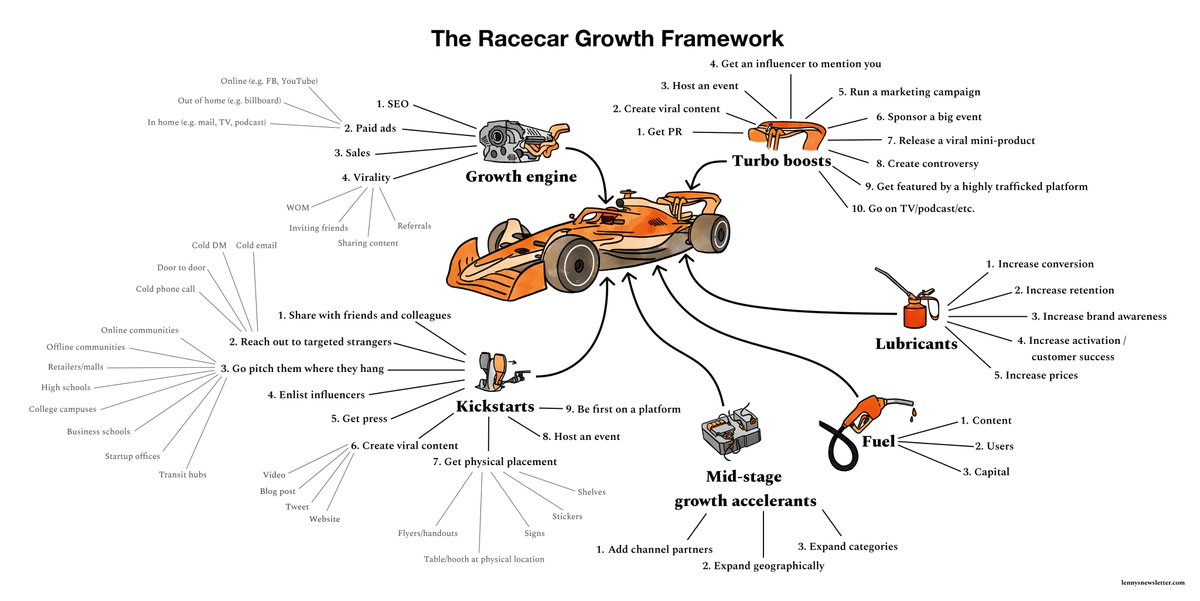 ([View Tweet](https://twitter.com/lennysan/status/1579843486672556033))
- I always ask my podcast guests what books they recommend most to others.
From that list, I picked the 10 most mentioned, and I'm giving them away to a few lucky winners 💝
To enter the giveaway:
1. Share my podcast with 2 friends
2. Fill out the short form below
Good luck! https://t.co/uWEuaQD3W2
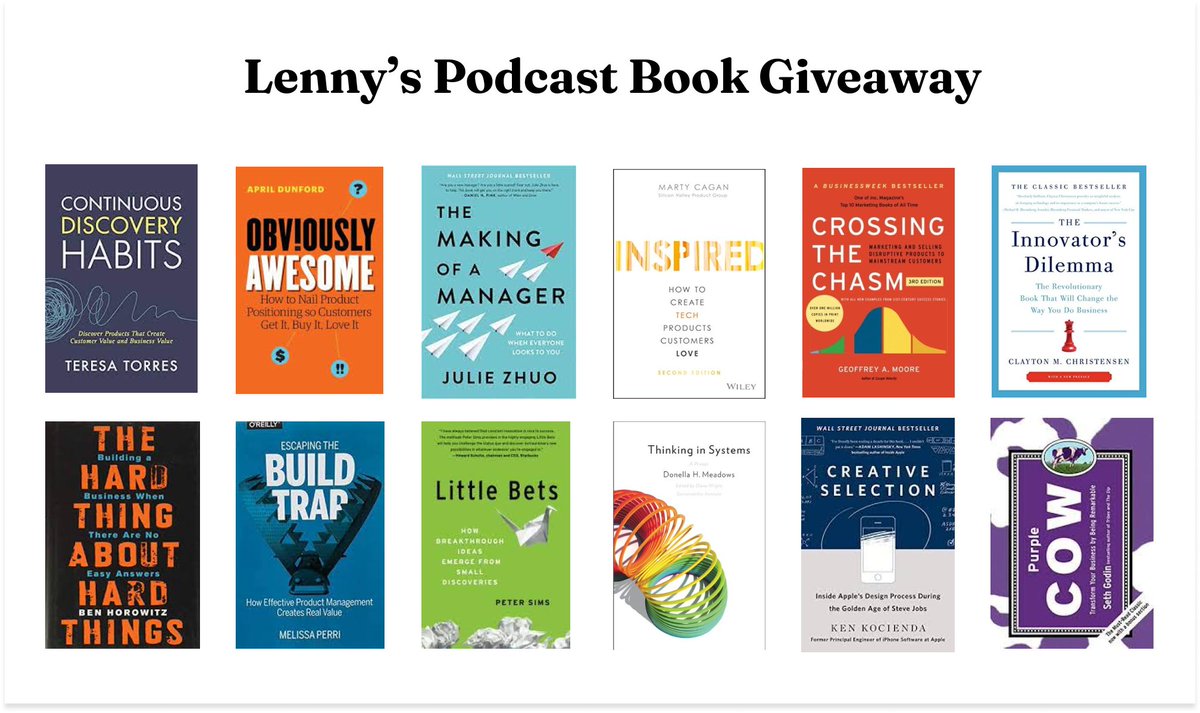 ([View Tweet](https://twitter.com/lennysan/status/1580253303023075328))
- The Mochary Method Curriculum ➔ https://t.co/A8J51IzYhz
My recent conversation with @mattmochary where we talk about fear, anger, innovation, how to lay people off well, and his coaching practice ➔ https://t.co/bbtF83qTaI ([View Tweet](https://twitter.com/lennysan/status/1591470518125072384))
- How @Linear builds product:
1. **No product managers, just a head of product**. PM duties are distributed across engineering and design.
2. **No durable cross-functional teams**. Teams assemble around a project and disperse once the project is done.
3. **No metrics-based goals**. Just a North Star company-level metric goal.
4. **No A/B tests**. Decisions are based on taste and opinions.
5. **Job candidates go through a paid work trial**. They join the team for 1-5 days and work on a real project with the team.
6. **The team is completely remote**. And always has been.
Also, they have more cash in the bank than they’ve ever raised in VC funding, they’ve been profitable for 2+ years (before it was cool), and have spent a grand total of $35K on paid marketing in the history of the company. Only two people have ever left the company, and their CEO, Karri Saarinen, is a designer (who rarely gives interviews).
To get an in-depth glimpse into how Linear builds product, see link below for my interview with @karrisaarinen ([View Tweet](https://twitter.com/lennysan/status/1706685617726443842))
- Per my yearly tradition, I’ve revisited *every single* newsletter post and podcast episode since day one (over 400 of them!), picked out the cream of the crop, and organized them by their job-to-be-done.
This post is now the single best way to find my best stuff across both the newsletter and podcast.
🔗 https://t.co/bFCl2oi4Bf
Inside:
1. I want to hone my product skills
2. I want to grow my product
3. Help me kickstart and scale my startup
4. I’m feeling stressed and overwhelmed
5. I want to accelerate my PM career
6. I want to learn from how the best companies operate
7. I want to become a better leader
8. I need some benchmarks
9. I need help hiring or interviewing
10. I want to get better at pricing
11. I want to get better at sales
Bookmark this for future reference.<img src='https://pbs.twimg.com/media/GBKS3SvbQAAZEA9.jpg'/> ([View Tweet](https://twitter.com/lennysan/status/1734616002028294336))
- To kick off 2024 with a dose of inspiration, here are my 19 favorite life mottos shared by my podcast guests this year:
1. “Strive not to be a success, but rather to be of value.” —Albert Einstein (via @ItamarGilad) ([View Tweet](https://twitter.com/lennysan/status/1742238469278302689))
- Every startup can be distilled into a simple equation.
And until you can express yours as one, you don’t fully understand your business.
Having this equation gives you a map for understanding your biggest growth drivers, your key inputs and output, and once your teams are aligned behind it, and the equations operationalized, you’ll experience a huge force multiplier—because every team will be focusing their energy on the same (high-leverage) levers.
I teamed up with <a href="https://twitter.com/danhockenmaier">@danhockenmaier</a> to collect the detailed equations for the eight most common tech business models:
1. Bottom-up B2B SaaS with seat-based pricing
2. Bottom-up B2B SaaS with usage-based pricing
3. Top-down B2B SaaS
4. B2C subscription
5. B2C free (ads)
6. B2C marketplaces
7. B2B marketplaces
8. DTC/e-commerce
👇🧵<img src='https://pbs.twimg.com/media/GD-mKwPaoAET8dD.jpg'/> ([View Tweet](https://twitter.com/lennysan/status/1747304157084848344))
- - Editing: I work with https://t.co/wMcqhV8Wum and https://t.co/A6Q7AoIVSc, and I believe they use @DescriptApp and @Frame_io
- Website hosting: @PodpageHQ
- Charts: @podstatus
P.S. Get an editor/producer as soon as you. Makes podcasting SO much easier. ([View Tweet](https://twitter.com/lennysan/status/1665874914241568768))

## New highlights added October 4, 2024 at 9:07 PM
> A PM’s guide to influence by [julesdwalt](https://twitter.com/julesdwalt)
> Five proven tactics to align stakeholders so decisions go your way:
> 1. Seek intel on how each stakeholder makes decisions
> 2. Frame your message from their POV (not yours)
> 3. Prime detractors and champions alike in the “meeting before the meeting”
> 4. Make people feel heard and validated
> 5. Manage the clock
> Don't miss this one: https://t.co/ldwOaPiIVX
>  ([View Tweet](https://twitter.com/lennysan/status/1841135468978848199))
> Influence tactic #1: Seek intel on how each stakeholder makes decisions
> To effectively influence stakeholders, the first step is to understand how each person makes decisions––what they value (e.g. goals, incentives), who they consult, and what they’re afraid of. I usually start by setting up one-on-ones with key stakeholders (or people who know them), to understand their POV.
> At YouTube, I needed the leads of a critical partner team to prioritize a feature that would otherwise delay my project by at least a quarter. I set up one-on-one meetings with the PM and engineering leads on their team. I explained to them what my project was trying to achieve, but also, more importantly, I asked questions such as:
> - What are the top goals and OKRs of your team? (I’ll later need to show how my project might contribute to those goals.)
> - What projects do you think will contribute the most to these goals? (These are the top projects I’ll be competing against.)
> - What’s your process for deciding what to take on each quarter? (I want to understand the steps I’ll need to go through and key deadlines I shouldn’t miss.)
> - Who are the key decision makers? What do they each care about? Who do they listen to? (I need to know which stakeholders to focus on, in what order, and how to approach conversations with them.)
> - What concerns do you anticipate them having about my project? (Getting ahead of identifying detractors and their arguments.)
> - How might I frame my project to increase the chances they support it? (An ask for advice from people who know the stakeholders the most.)
> When having these early discussions, I first focus on establishing rapport. I convey that I’m seeking information at this point and not trying to convince them, because for people to share intel, they need to feel safe. They need to know that I’m here to listen, not argue with them, and that the info they share won’t be used against them at a later point. I start with statements like “This conversation is meant to be an informal chat. I’d like to better understand your world and get your advice as I’m looking to [explain my goals] and make things easier for everyone.”
> Another way I find intel on stakeholders, especially executives, is to pay attention to what they say in other meetings and forums. I keep a notes doc where I write down the questions execs ask and the feedback they give. This helps me identify their patterns and anticipate questions and reactions for future discussions when I need their support. Below is what a notes doc might look like.
> Based on the intel I gathered about the partner team at YouTube, I realized it wouldn’t be enough to emphasize how strategic my project was to the company. The partner team had a long backlog of requests from other teams that I was competing against, and they needed more confidence in my project’s expected impact on a particular metric they cared about. So I decided to walk key folks on that team through my project’s detailed forecast model to show that we would contribute meaningfully to their goals. I also recommended specific projects they could potentially deprioritize. This informed approach made it easier to influence that team, and they decided to support my team’s project, which allowed us to launch on time. This experience was a good reminder that I shouldn’t assume that others will agree that my project is a priority for the business—a tendency we PMs have—and instead be prepared to think through the right framing for my ask and provide impact assessments and other info that can help make tradeoff decisions compared with other projects.
>  ([View Tweet](https://twitter.com/lennysan/status/1841185264783540554))

## New highlights added October 17, 2024 at 12:53 AM
> If you're feeling overwhelmed at work—no matter how many productivity tactics you've tried—today's post is for you.
> Natalie Rothfels ([natatouille](https://twitter.com/natatouille)) is a full-time executive coach, facilitator at [StanfordGSB](https://twitter.com/StanfordGSB) ’s Interpersonal Dynamics course (aka “Touchy Feely”), certified Internal Family Systems practitioner, and former product leader at [KhanAcademy](https://twitter.com/KhanAcademy) and [Quizlet](https://twitter.com/Quizlet).
> Her coaching clients come to her feeling stuck, burnt out, and looking for productivity tricks. They are trying to strong-arm their way through overwhelm and exhaustion using coping mechanisms and tactics that were once effective but no longer are. They can often recite every productivity tactic, but they’re still unproductive, primarily because they are people-pleasing and have poor internal awareness of how much they can physically get done. It sends them into emotional overwhelm, which then sends them into internal shaming, which then is a huge blocker to any productivity.
> In her powerful and raw guest post, Natalie shares how looking outside ourselves to solve our overwhelm is a trap, and that to get to the next level externally, you have to start by looking inside.
> Bonus: snippets from a live coaching session with me!
> Don't miss this one https://t.co/A2MTAGT1xS ([View Tweet](https://twitter.com/lennysan/status/1846227258530583034))

## New highlights added November 4, 2024 at 6:12 PM
> Five proven prompt engineering techniques (and a few advanced tactics).
> A handy cheat sheet to get exactly what you want when working with AI. https://t.co/yncGUJ5g0h
>  ([View Tweet](https://twitter.com/lennysan/status/1851297976372904106))

## New highlights added November 25, 2024 at 5:11 PM
> If 2024 was the year of the super IC, 2025 might be the year of the supermanager.
> In today's mind-blowing post, [yourgirlhils](https://twitter.com/yourgirlhils) shares five strategies that she's implemented to scale herself as a manager using the latest AI tools, including:
> 1. Leveling up her team’s writing skills with her custom built GPT “The Executive Editor”
> https://t.co/yRHXvsz4d9
> 2. Turning her team into debate champions with her custom built "Product Management Logic Coach" GPT
> https://t.co/mI71lxx0y3
> 3. Helping her team master synthesis skills with these prompts she's crafted for her team
> https://t.co/1fRtJahmOu
> 4. Building a custom GPT that thinks like her on-demand
> https://t.co/mRpvsdqsuJ
> 5. Teaching her team how to use AI as a thought partner using this curriculum she's developed
> https://t.co/fTd52cWM7G
> Don't miss the full post 🔥
> https://t.co/bEXNCfNOOi
>  ([View Tweet](https://twitter.com/lennysan/status/1858902343762538547))

## New highlights added December 10, 2024 at 7:53 PM
> I've always wanted to know which companies create the best product managers. I finally have answers.
> I teamed up with [GotLiveData](https://twitter.com/GotLiveData) to see which companies’ PM alumni go on to see:
> 1. The most promotions
> 2. The fastest immediate promotion
> 3. The fastest rise to leadership roles (e.g. to VP, CPO, Head of Product)
> 4. The highest rate of becoming CPOs and Heads of Product
> 5. The highest rate of becoming the first PM at another company
> 6. The highest rate of becoming founders
> Out of this, we triangulated a list of top 10 companies that create the biggest inflections in the careers of their PM alumni. Here's the list:
> 1. [RevolutApp](https://twitter.com/RevolutApp)
> 2. [n26](https://twitter.com/n26)
> 3. [eBay](https://twitter.com/eBay)
> 4. [Plaid](https://twitter.com/Plaid)
> 5. [Intercom](https://twitter.com/Intercom)
> 6. [Intuit](https://twitter.com/Intuit)
> 7. [LinkedIn](https://twitter.com/LinkedIn)
> 8. [PalantirTech](https://twitter.com/PalantirTech)
> 9. [Deel](https://twitter.com/Deel)
> 10. [Discord](https://twitter.com/Discord)
> Here's the full post with all of the data and analysis: https://t.co/BJVB3gVlFK
> My biggest surprises and takeaways:
> 1. **The top two companies are based in Europe!** One in London, one in Berlin. Go Europe!
> 2. **Fintech is dominant—5 out of the top 10 companies! **Did not expect that. It’s probably no coincidence that the PayPal mafia has been so successful. One explanation, shared by my buddy Dennis Yang (PM at Chime), is that fintech nurtures strong product leaders because fintech work is on hard mode—lots of risk/fraud vectors, difficult stakeholders (e.g. compliance, regulations), and endless complicated tradeoffs. Another explanation could be that fintech PMs leave to join other fintech companies or start fintech startups, and since they know that space well, they’re more likely to thrive.
> 3. **We have a new set of startup mafias:** Palantir, Plaid, N26, Ramp, Intercom, Revolut, Duolingo, Uber, Notion, and Coinbase. The standout company is Palantir, where almost a quarter of Palantir PMs went on to start their own company. Almost a fifth of Plaid PM alumni went on to start a company, which is also incredible. Of older and larger companies, LinkedIn, Google, Intuit, and eBay made it into the top 15. Impressive! Props to LinkedIn for being the most founder-friendly big company.
> 4.** FAANG companies lag behind. **eBay, Intuit, and LinkedIn are far ahead of companies like Microsoft, Google, Apple, Meta, and Amazon in these lists. One explanation is that PMs at FAANG companies learn how to operate well within that specific company and are less successful elsewhere. Another explanation is that the best PMs at FAANG companies are happy and don’t leave, and so we don’t see their trajectories in the data.
> 5. **There are an equal number of B2B and B2C in the top 10.** You can do great no matter which direction your career goes.
> **Notable mentions:**
> 1. [TryRamp](https://twitter.com/TryRamp) (~800 employees, founded 2019): Particularly strong at creating founders—which is extra impressive since it’s so young.
> - Ranked 3rd at founder rate
> - Ranked 5th at first PM rate
> - Ranked 10th at time-to-next-promotion after leaving
> 2. [Nubank](https://twitter.com/Nubank) (~7,000 employees, founded 2013): Strong all around but not ranked highest on any specific dimension.
> - Ranked 6th at Head of Product rate
> - Ranked 7th at first PM rate
> - Ranked 8th at fastest risers
> - Ranked 9th at fastest promotion
> 3. [NotionHQ](https://twitter.com/NotionHQ) (~500 employees, founded 2013): Especially strong at creating first PMs at other companies.
> - Ranked 2nd at first PM
> - Ranked 4th at CPO rate
> Don't miss the full post with tons more: https://t.co/BJVB3gVlFK
> 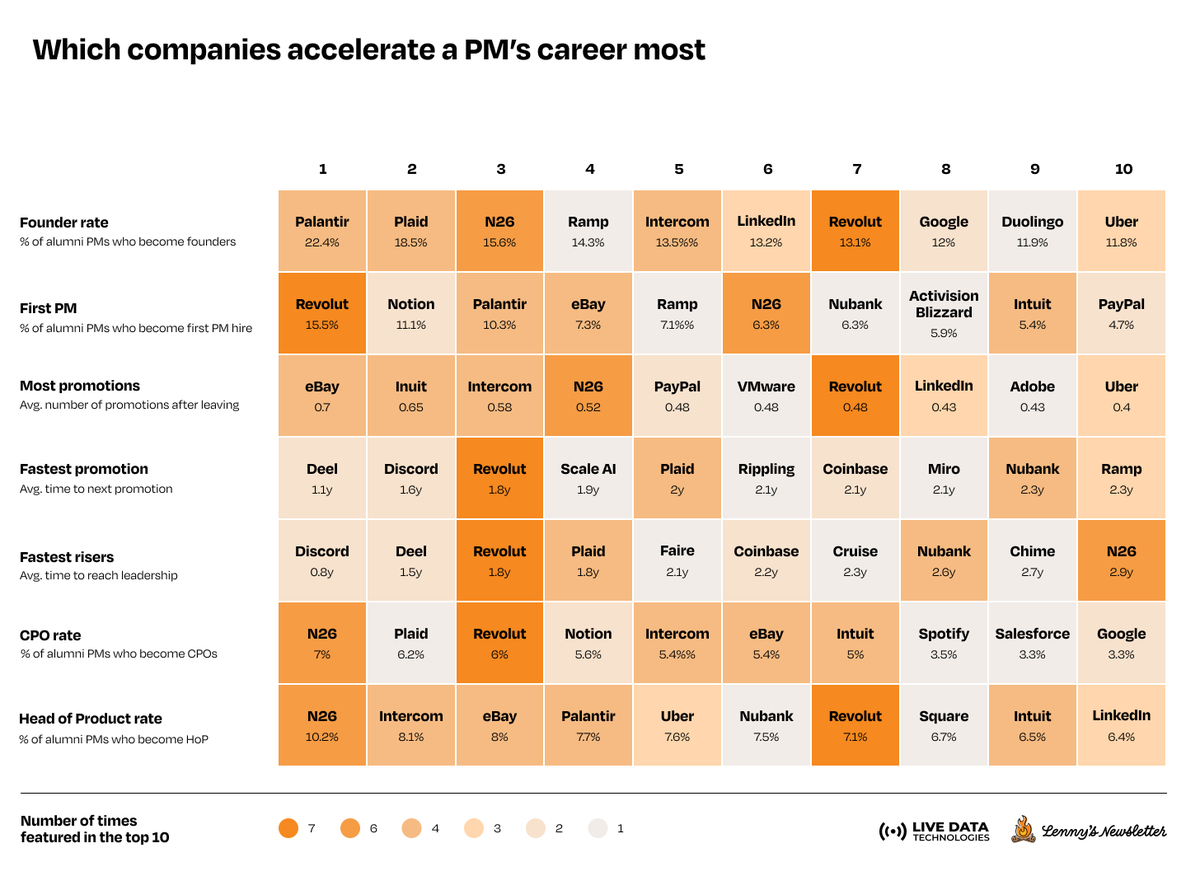
>  ([View Tweet](https://twitter.com/lennysan/status/1866520360637833232))

## New highlights added December 20, 2024 at 8:39 PM
> 🚨 MEGA THREAD—My all-time best posts and podcast episodes categorized by the problem you need solved 🚨
> 1.** I want to grow my product
> 🔸** How the biggest consumer apps got their first 1,000 users: https://t.co/R7SyMxuyFE
> 🔸 The Racecar Growth Framework: https://t.co/Kjeu1wCQnb
> 🔸 How to increase conversion: https://t.co/RMlQpACry8
> 🔸 How to increase retention: https://t.co/aXAodVss7G
> 🔸 How to do SEO: https://t.co/AJe2gCCZtz
> 🔸 How to do sales: https://t.co/T4Ev6fteWm
> 🔸 How to build a sales org: https://t.co/x9ObKzZwBf
> 🔸 How to do paid growth: https://t.co/1TNbzTa5sb
> 🔸 How to increase virality: https://t.co/DywH7aeUsJ
> 🔸 GTM motions of 30 B2B SaaS companies: https://t.co/BHNb2BiEwU
> 🔸A list of growth ideas to steal: https://t.co/WmOT9Z3zqo
> 🔸 How Duolingo reignited user growth: https://t.co/q8THU0sN5w
> 🔸 How to consistently go viral: Nikita Bier’s playbook for winning at consumer apps: https://t.co/y7ThqIQme4
> 🔸 Crafting your positioning: https://t.co/Iv4yzV1AaA
> 🔸 How to describe your business as an equation: https://t.co/IhwXhTlScS
> 🔸 A framework for growing consumer subscription businesses: https://t.co/ttggKdHjI7
> 2. I want to learn how **to build better products
> 🔸 How the best companie**s build product: https://t.co/XwqWUsbrUQ
> 🔸Mission → Vision → Strategy → Goals → Roadmap → Task: https://t.co/V0JQbWAbsB
> 🔸 How to develop first-principles thinking: https://t.co/EroV0aHnH0
> 🔸How to get better at product strategy: https://t.co/XjuFwi25DN
> 🔸 How to develop product sense: https://t.co/R8E4Q6zTjO
> 3. I need benchmarks
> 🔸 What is** good retention: **https://t.co/3cuWaWaSHW
> 🔸 What is a good activation rate: https://t.co/V3WheJJXgl
> 🔸 What is a good payback period: https://t.co/daQhb2U9Zk
> 🔸 What is good monthly churn: https://t.co/iSDbQptVBt
> 🔸 How to measure cohort retention: https://t.co/7PN70M8LUv
> 🔸 What is a good growth rate: https://t.co/jVDlKtBWoi
> 4. I want to become a better leader and** manager
> 🔸 The framework for performance review**s to become a better manager: https://t.co/FIeaUTTLQj
> 🔸 The secret to a great planning process: https://t.co/pgbEiC5uSo
> 🔸 How to become a supermanager with AI: https://t.co/bEXNCfNOOi
> 🔸 My favorite decision-making frameworks: https://t.co/3eANNPmBLr
> 🔸 Why most public speaking advice is wrong—and how to finally overcome your speaking anxiety: https://t.co/x9nz2WLhn3
> Continued 👇 ([View Tweet](https://twitter.com/lennysan/status/1869105496013373761))

## New highlights added February 26, 2025 at 6:24 PM
> **WTF is product strategy**
> Product strategy sits in between the mission/vision and the plan, either at the company level or at the team level.
> At the company level, the mission and vision are typically articulated by the founders/CEO and tend to be durable over time.
> The plan (i.e. roadmap) is an ordered list of projects based on some notion of prioritization and sequence of delivery.
> There is a steep drop in elevation between the mission/vision and the plan, and strategy occupies this large void.
> **Strategy exists to force a disciplined choice to deploy scarce resources for maximum impact.** Regardless of the size of a company, the resource pool and capacity to get work done is always constrained relative to the universe of work that could be done—making this choice a critical decision in every single context.
> A good strategy articulation typically includes three components:
> 1. 3 to 5 areas for the company or the team to focus on, which we will henceforth refer to as strategic pillars
> 2. Several areas that should explicitly not be the focus
> 3. A clear set of explanations for why these choices were made
> Here's a step-by-step guide to crafting the two types of product strategy:
> 1. A 2-year strategy, which is typically focused on solving problems with the current product, i.e. small “s” strategy
> 2. A 3/5/10-year strategy focused on aspirational futures. i.e., big “S” strategy
> Bookmark this for the next time you're working on a strategy: https://t.co/UL7z8SBpZs
> 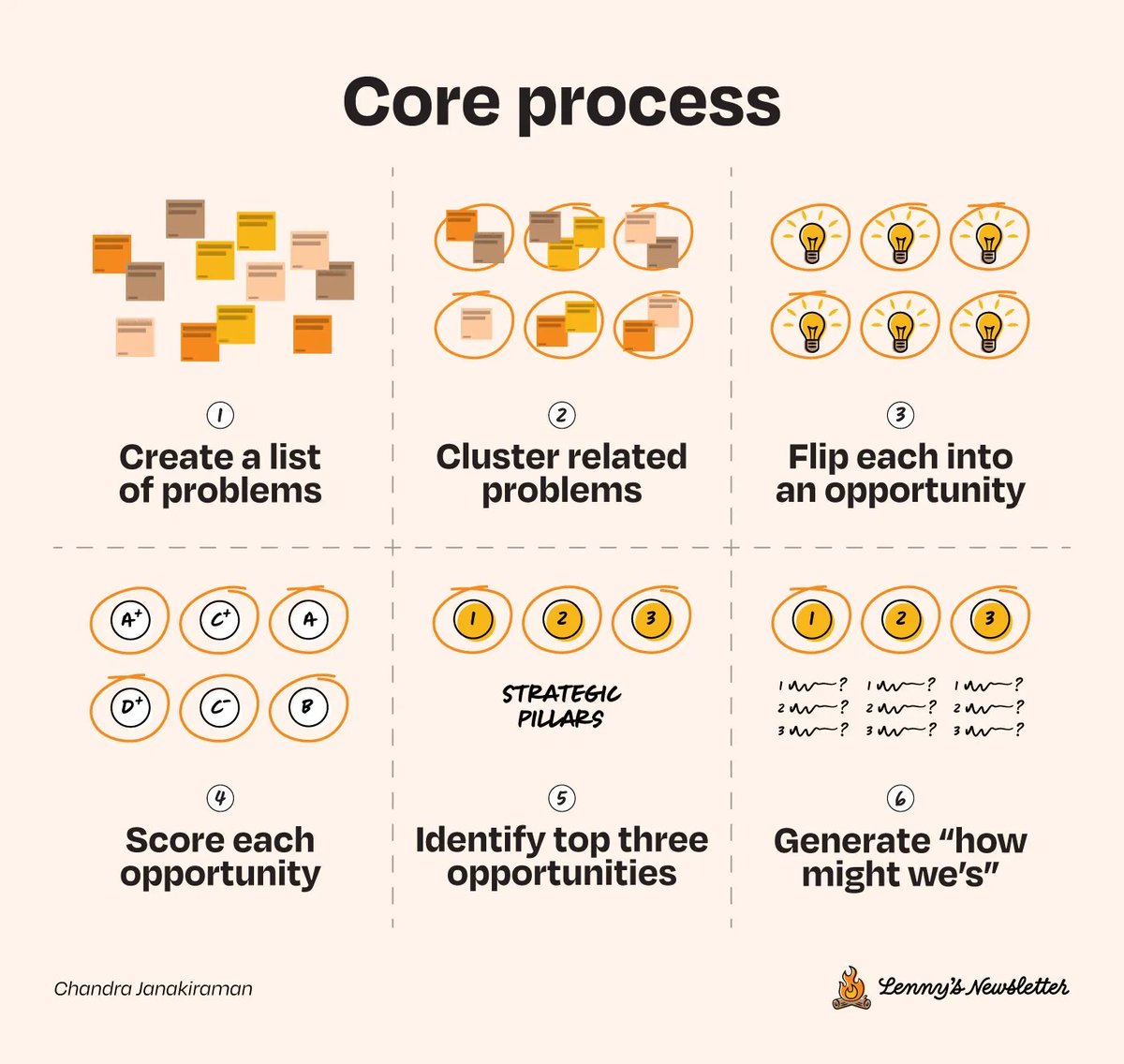 ([View Tweet](https://twitter.com/lennysan/status/1894821514681426005))

## New highlights added March 13, 2025 at 2:51 AM
> Why you’re so angry at work (and what to do about it)
> Executive coach Natalie Rothfels ([natatouille](https://twitter.com/natatouille)) has noticed a concerning pattern across all of her founder and executive clients recently: everyone is vibrating with anger. Not mild frustration—deep, persistent anger that was depleting their motivation and sense of ownership and making them emotionally exhausted at work.
> Below, she shares a guide to identifying and then transforming anger into wisdom that she’s been putting into practice with her clients. It honestly made me well up the first time I read it. This post may completely change your relationship with work.
> Check it out: https://t.co/WP8Znx3v5n
>  ([View Tweet](https://twitter.com/lennysan/status/1899478080399552929))

## New highlights added May 13, 2025 at 9:03 PM
> The ultimate guide to negotiating your comp
> Two equally qualified product leaders walk into the same negotiation. One leaves with a standard package—market-rate base salary, typical equity, standard benefits. The other walks away with double the compensation, accelerated vesting https://t.co/4hAchUSHj6
>  ([View Tweet](https://twitter.com/lennysan/status/1919768784392622110))

## New highlights added June 9, 2025 at 5:24 PM
> Hug your designer https://t.co/lc4pIgEcAL
>  ([View Tweet](https://twitter.com/lennysan/status/1927755490064265564))

## New highlights added June 16, 2025 at 11:44 AM
> How do you make your prototypes look good enough to show customers (or senior stakeholders)?
> How do you successfully adopt these tools as a team, instead of a lot of individuals working in silos?
> Over the past year, [colinmatthews](https://twitter.com/colinmatthews) has taught thousands of product leaders how to get the most out of AI protyping tool (he's my go-to AI prototyping expert, and author of two of my top ten most popular posts of all time), and he's seen these two questions come up most often when people try to use these tools in real life.
> In today's post, Colin shares a practical guide to creating AI prototypes that match your brand and are integrated into every step of your development lifecycle
> He walks you through:
> 1. Three ways to create component libraries that consistently create great mocks
> 2. Team workflows to reduce rework
> 3. A step-by-step guide on how prototypes should be used within your product development lifecycle
> The guide includes advice for working with [v0](https://twitter.com/v0), [boltdotnew](https://twitter.com/boltdotnew), [Cursor](https://twitter.com/Cursor), and [MagicPatterns](https://twitter.com/MagicPatterns), but these techniques work with any AI prototyping tool.
> Read this and share it with your team: https://t.co/VPYCi55WIL
> 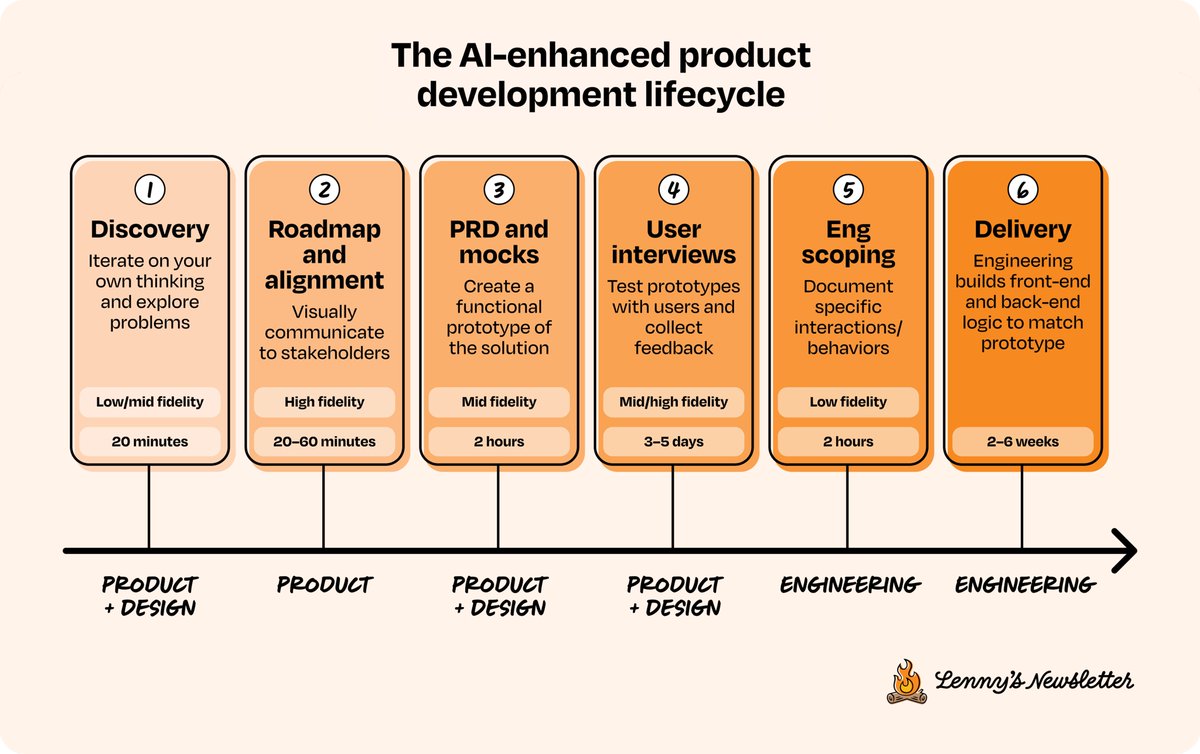 ([View Tweet](https://twitter.com/lennysan/status/1932473395515711792))